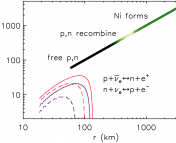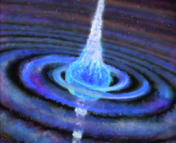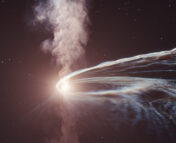Title: Exploring the Fate of Stellar Core Collapse with Supernova Relic Neutrinos
Authors: Ashida, Yosuke and Nakazato, Ken’ichiro
First Author’s Institution: Dept. of Physics and Wisconsin IceCube Particle Astrophysics Center, University of Wisconsin–Madison, Madison, WI 53706, USA
Status: Posted on ArXiv
Escaping from the most extreme matter in the universe, neutrinos carry vital information about the formation of neutron stars and black holes. The authors of today’s paper seek to uncover what is hidden in the final moments of a massive star’s death. To this end, they outline the feasibility of measuring the background flux of “relic neutrinos” and connect them to their origins. The authors determine that future neutrino detectors will be able to constrain where the background flux of neutrinos originate, and in turn, elucidate mysteries of stellar demise.
What is a Relic Neutrino?
As a massive star dies, its innermost core compacts to incredible densities. As the interior crumples upon itself, its gravitational might increases dramatically. As a result, the stellar layers just outside the core want to rain down and condense on the center. Unfortunately, the core quickly reaches maximum capacity, as defined by its equation of state, and the proto-neutron star and rejects all further material, regardless of gravity’s might.
In a last-ditch effort to reclaim equilibrium, the hot, dense core desperately attempts to cool as drastically as it knows how: through the release of neutrinos. Astronomers currently believe the pressure from the large expulsion of neutrinos is what fully launches the outer layer of a star, the explosion we observe as a supernova (SN).
As you can likely imagine, the surroundings the neutrino must travel through are extremely dense. So dense, in fact, that light from this stage of a stellar death requires hours to escape. As a result, observers are left with a rather basic conundrum: they observe “compact objects” like black holes and neutron stars existing in nature, and they also watch supernovae explode. Yet, they cannot directly connect compact object formation to the type of supernova that caused it.
Though supernovae are rather common, there has been only a single recorded instance of a neutrino associated with its supernova: SN 1987A. Because neutrinos are both incredibly fast and small particles, they don’t interact with matter much at all. This also means they don’t interact with our detectors often, often passing right through the entire earth, and are difficult to observe.
The authors of today’s paper, pose an alternative to waiting for another rare, chance neutrino-SN association. Instead, they propose to collect every neutrino we see, and analyze the population in full. Then they ask, “How many of these neutrinos originate from core-collapse supernovae? What was the nature of the compact object that was born?” These neutrinos without a direct SN association are called “relic neutrinos,” as they were likely born in a core-collapse supernovae, but we have lost knowledge of the civilization they came from.
Where Could Relic Neutrinos Come From?
When nature needs to get rid of a lot of energy very quickly, neutrinos are a highly effective “panic button.” However, neutrinos can occupy a broad range of energies. The authors choose to focus on an energy range bookended by solar neutrinos, detector neutrinos, and cosmic rays on the low end (less than 17.3 MeV), and the atmospheric neutrino background is the dominant contributor at energies greater than 17.3 MeV . A different energy range would still encapsulate information from compact objects, but this seems a reasonable place to focus, devoid of potential non-compact-object pollutants.
But let’s get to the good stuff! What are the very first words of a brand-new neutron star?! Ashida and Nakazato reason that if we collected relic neutrinos in a specific energy range, three extremes can possibly be observed:
(i) all neutrinos come from normal-sized neutron stars (about 1.35 M),
(ii) all neutrinos come from rather large neutron stars (1.6 M),
(iii) all neutrinos come from black holes accreting material.
Of course, nature will produce a combination of these three. However, an important aspect of research is to consider what’s possible by analyzing the extremes, and then narrow-in on the exact details and complicate the model further in future work.
Another question you may have is, “why differentiate between normal and large neutron stars?” The true difference between all three cases is what the neutron star is made of: whether or not it can support larger masses, or collapses directly into a black hole, all depends on its equation of state, similarly to how water’s equation of state dictates under what conditions it turns to ice or steam. The neutron star equation of state is a huge open question in science. Because of this, Ashida and Nakazato explore three different equations of state, leading to different probabilities of any of the three end-states occurring (Figure 1).

The Experiment
As we’ve mentioned, the authors investigate the three extremes, assuming nature produces only one outcome and all neutrinos follow that outcome. They then consider how this might change if they also shift the underlying equation of state. But there is one final complication. Neutrinos “oscillate.” There are three types of neutrino, and they are known to change type (and consequently, their mass) as they travel. However, the hierarchy of these changes is still unknown. So, in addition to neutrino birthplace and underlying equation of state, the authors calculate predictions for both forms of neutrino mass hierarchy, denoted as “normal” and “inverse” (NH and IH in Figure 1).

Every combination of these considerations (there are 18 in total!) is a separate line plotted in Figure 2. The purpose of this plot is to show the expected flux of neutrinos at a given energy, as a function of time and area of the detector. If the collected neutrinos follow one of these 18 possible lines exactly, for example, one of the green solid lines, then one would conclude that 100% of the neutrinos in the energy range 10—30MeV were produced in black hole systems, they all follow the “normal hierarchy” of mass, and neutron stars obey that particular equation of state.
That would be three major mysteries, all solved at once! Unfortunately, nature is rarely so straightforward, so the authors have created this as an extremely useful guide from which to build future speculation, or to even rule-out scenarios.
To this end, they have plotted about 8 and 12 years’ worth of data collection from two detectors, Super-Kamiokande (SK-IV) and KamLAND, respectively (Figure 2). It appears as though some models already agree with observations! Most importantly, scientists looking to build future detectors will use plots just like this to determine how sensitive they should be, and how much data is needed to solve these mysteries!
Astrobite edited by Katya Gozman
Featured image credit: https://neutrinos.fnal.gov/ and kcl-antiquities.co.uk




